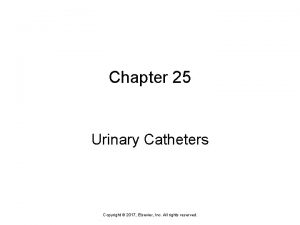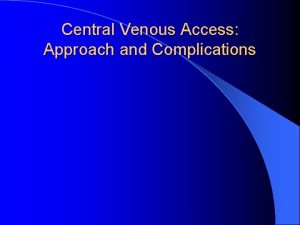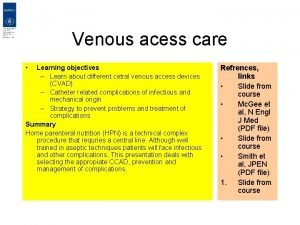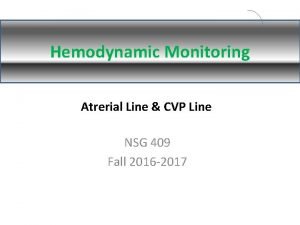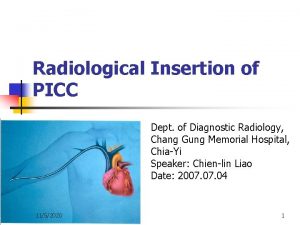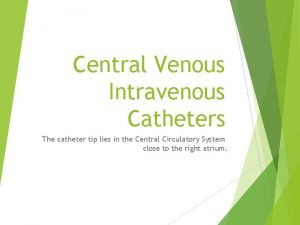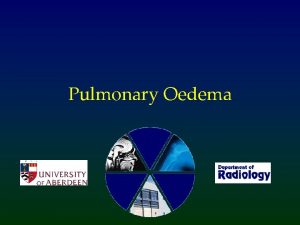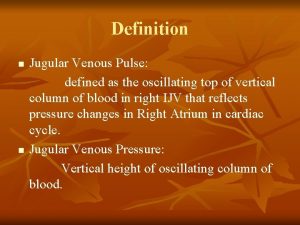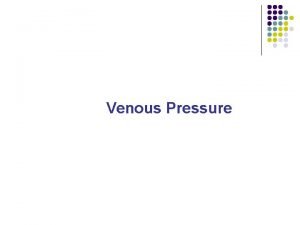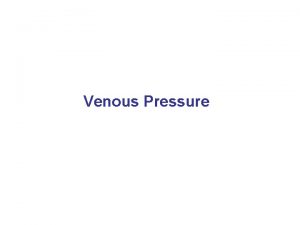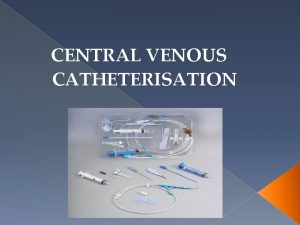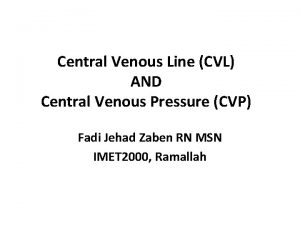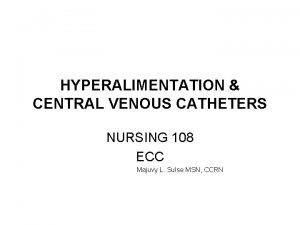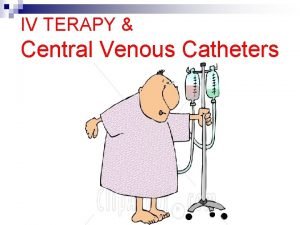Removal of Central Venous Catheters Removal of Short









- Slides: 9

Removal of Central Venous Catheters

Removal of Short Term Catheters n Single, double, and triple lumen catheters (short term) n Dialysis catheters (short term, Trialysis used at ALH) n PICCs (even though this is not a short term catheter, it is removed by an RN) n All of these (nontunnelled catheters or PICCs) may be removed by a trained RN

Removal of Long Term Catheters n Tunnelled/Cuffed n n Catheters (for stability and infection control): Dialysis catheters (Permacaths, Hemostar at ALH) Groshong Broviac Hickman n Implanted Ports: n Port-a-caths n. All of these must be removed by an MD

Discontinuing Central Catheters (Short term & PICCs) n Check chart for length of catheter n Lay the patient flat (if able), with head turned away n Sterile gloves n Sterile dressing n Ask patient to hold breath n n n Mask, clean gloves n Remove old dressing and sutures n n and bear down If patient cannot hold breath, remove during expiration For PICCs, have patient bear down during the removal of the last few centimeters of catheter Slowly remove catheter For PICCs, arm at 90 degree angle to body may assist with removal

Discontinuing Central Catheters (Short term & PICCs) n Hold pressure x 10 min or n Apply sterile 4 x 4 s until bleeding stops n Dress with sterile petrolatum gauze n Tape or apply transparent n n n dressing over gauze dressing Write on dressing “Do not remove for 24 hours”, initials, date, time After 24 hours, if site closed, may leave dressing off If not closed, redress Inspect site every 24 hours Continue to redress until site closes.

Notifying Physician and Documentation n Compare total length removed with length placed n Notify physician if difference is noted n If catheter breaks during removal, apply direct pressure to vein high in arm, notify physician immediately n Document date, time, catheter’s condition and length at time of removal, condition of insertion site and type of occlusive dressing applied

Air Embolism n Air can track through skin to vein if precautions are not taken during removal…patient flat, Valsalva maneuver, petrolatum gauze and 4 x 4 s n 4 x 4 dressing alone is not an occlusive dressing

Air Embolism: Signs & Symptoms n Air Embolism (CV n Tachyarrhythmias & Neuro S&S) n Sudden onset SOB n Coughing n Chest pain n Hypotension n Jugular vein distention n Wheezing n Increased RR n Altered mental status n Changes in facial appearance, numbness, paralysis

Air Embolism: Treatment n Immediately place patient in left lateral decubitus n n n position if not contraindicated Call for help Airway (open if needed) Breathing (oxygen, bag if needed, assess RR and effort) Circulation (CPR if needed or if pulse, check HR, BP, pulses, color) Call physician

